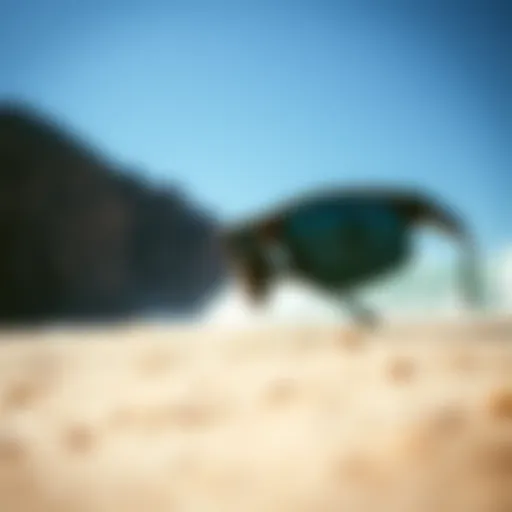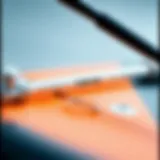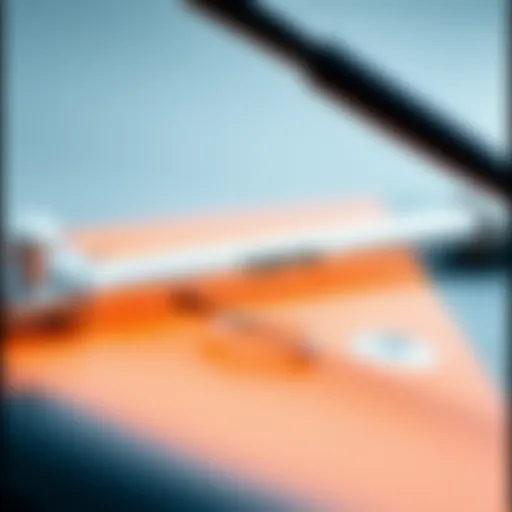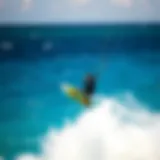Naish Kite Lines: Performance, Safety, and Selection

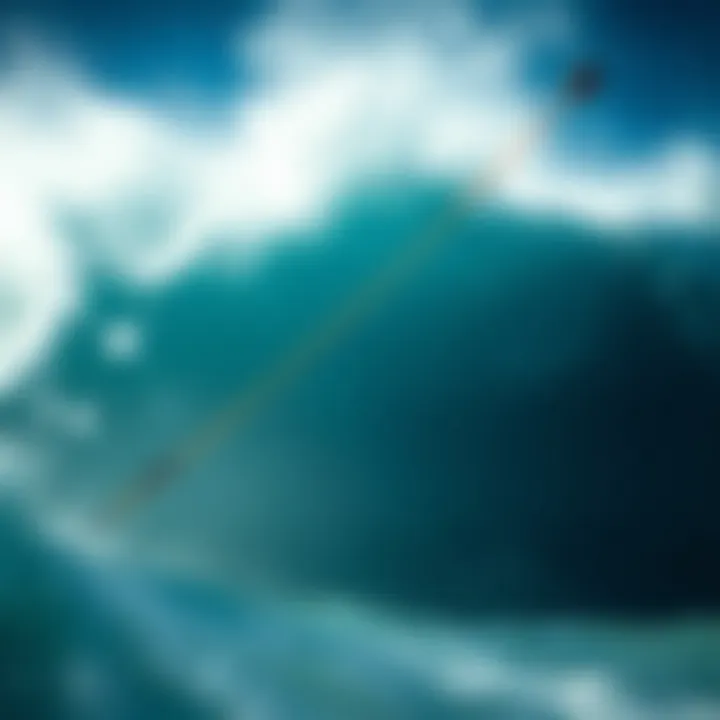
Intro
Kiteboarding, with its roots in both surfing and sailing, has seen a dramatic rise in popularity in recent years. This surge not only highlights the thrill of gliding across the water but also brings to light the vital equipment that underpins this exhilarating sport. One of the key components of kiteboarding gear is the kite line, particularly those crafted by Naish, a brand synonymous with quality and innovation in the kiteboarding realm.
Kite lines serve as the lifeline—pun intended—for kiteboarders. They connect the rider to the kite, translating movements into harnessed power and control. As a result, selecting the right lines is not just about aesthetics or brand loyalty; it involves a keen understanding of performance, durability, and technical specifications.
Throughout this guide, we will delve into the fundamental aspects of Naish kite lines, examining everything from the materials used to their maintenance protocols. We'll also touch on the various types available, highlighting how each suits different riding styles and conditions. By the end of this guide, readers—whether they're just dipping their toes into kiteboarding or already carving up waves—will be better equipped to make informed decisions about their gear.
Understanding the significance of kite lines is crucial, as poor-quality lines can lead to catastrophic failures, affecting both performance and safety on the water. With the right knowledge and tools, kiteboarders can elevate their experience and enjoy the freedom that kiteboarding promises.
"A rider is only as good as their gear. If your lines aren’t up to snuff, as they say, it’s like trying to run a marathon in clown shoes."
So, buckle up as we embark on this comprehensive journey into the world of Naish kite lines.
Understanding Kite Lines
Kite lines are the lifeblood of any kite set-up, entwining the kiteboarder with their gear. They may seem like just a simple piece of equipment, but these strands of material play a pivotal role in the dynamics of kiteboarding. Understanding kite lines is essential not just for performance enthusiasts but also for safety aficionados. In this section, we’ll peel back the layers and explore what makes kite lines tick, their purpose, and their vital importance in kiteboarding.
Definition and Purpose
At its core, kite lines are the cords that connect the kite to the rider. They transmit the rider's control inputs, allowing for manipulation of the kite's angle, power, and position in the air. Kites are designed to harness the wind, and kite lines facilitate that relationship. Without them, the kite would simply float away—unsupervised, like a child without a leash.
The purpose of kite lines extends beyond just anchoring. They are also a conduit for power transfer. As the rider leans back and edges into the wind, the lines bear the weight and enable the kite to lift. Because of this, lines need to be strong yet flexible, giving the rider the ability to fly high and perform tricks while ensuring they are safe in the water.
So, when selecting kite lines, consider their length, strength, and the materials used—all of which influence performance. Not all kite lines are created equal; different designs suit different styles and conditions. The right kite line can make a notable difference in both safety and control, critical aspects for making the most of your kiteboarding experience.
Importance of Kite Lines in Kiteboarding
Kite lines are not just functional; they influence every aspect of your ride.
- Performance: The right kite lines can significantly enhance how your kite performs. For example, shorter lines might increase responsiveness, allowing quicker turns and less drag. On the flip side, longer lines offer more power and speed by letting the kite fly higher.
- Safety: Lines that are worn or damaged can present serious risks. Regular inspection is key. Investing in quality lines means ensuring a safer experience on the water. If a line snaps while you’re mid-air, it’s a recipe for disaster.
- Durability: Different materials offer varied levels of durability and weather resistance. It's worth noting that polyester and Spectra lines behave differently in varying conditions, which impacts your riding experience.
- Personalization: With so many options available, kite lines allow riders to tailor their kite setup. This customization can suit a rider's style, whether cruising casually or tackling aggressive maneuvers.
Naish Kite Lines Overview
Understanding Naish kite lines goes beyond mere performance metrics. They are a critical component of kiteboarding; mismatched or inferior lines can lead to lackluster experiences or even accidents. Naish lines combine advanced technology with years of expertise, providing kiteboarders with both reliability and performance enhancements. This section will explore the brand's history and the product range that has shaped contemporary kiteboarding.
Brand History and Evolution
Naish was established in the late 1970s, back when kiteboarding was barely a blip on the horizon. Robby Naish, a legendary windsurfer, started this journey driven by a passion for water sports that pushed the limits of performance and innovation. The brand first made its name in kitesurfing, but it didn’t take long for Naish to recognize the vital role of kite lines in the overall performance of its products.
The early days saw a focus on basic materials, but as technology advanced, so did their production techniques. Here are some key milestones:
- 1990s: Introduction of high-strength polyester lines, marking a significant leap in durability.
- 2000s: Launch of the Spectra line, which boasted lighter, stronger qualities, signaling a trend that many brands would follow.
- 2010s-Present: Continuous innovation with a focus on reducing stretch and increasing responsiveness, showcasing their dedication to the kiteboarding community.
Understanding this evolution gives insight into the meticulous thought that goes into creating each line. Naish has nurtured an ethos of reliability, embedding quality and safety with every product—which brings us to their current line of products.
Product Range and Innovations
Naish lines have diversified significantly since their inception. Their product range typically includes standard lines, performance lines, and specialty lines, catering to a variety of kiteboarding styles and conditions. This variety caters to both beginners and seasoned pros looking for specific traits in kite performance.
Standard Lines are designed for everyday use; they get the job done while offering decent performance for casual riders. The lines are durable, keeping up well in various conditions without breaking the bank.
Performance Lines, on the other hand, are engineered for elite riders. They feature advanced materials that reduce stretching and improve handling. Users often report a noticeable improvement in responsiveness and speed, which is key for those tackling high-intensity maneuvers.
Specialty Lines are tailored for niche applications—think freestyle or wave riding. They may incorporate unique construction techniques that enhance performance in specific contexts. Naish frequently rolls out limited editions or special collections, further showcasing their innovative spirit.
Adapting to the evolving demands of the kiteboarding community shows Naish’s commitment to investing in research and development. By continuously refining their lines, they ensure that kiteboarders not only have access to innovative gear but are also given the opportunity to elevate their riding experiences.
"The right kite line can make the difference between a good ride and a great one."
In summary, grasping the rich history and diverse product offerings of Naish kite lines underscores their significance within the kiteboarding world. Whether one is a beginner embarking on their first session or an experienced rider perfecting a trick, Naish provides a spectrum of options to enhance both safety and enjoyment.
Types of Naish Kite Lines
Understanding the varying types of Naish kite lines is essential for any kiteboarding enthusiast looking to optimize their performance on the water. The kite lines can drastically influence how a kite handles, responds to wind conditions, and interacts with the rider's inputs. Naish, being a pioneer in the kiteboarding industry, provides several distinctions in kite lines to cater to different styles and skill levels.
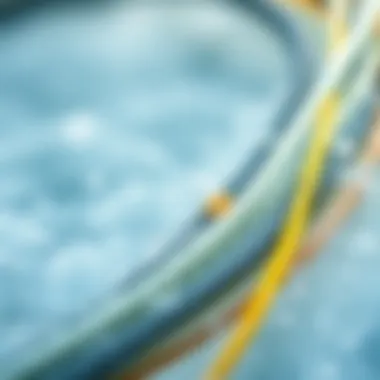

Standard Lines
Standard lines from Naish are designed for everyday kiteboarding activities. These lines are typically made from durable materials like polyester, which offers a balance of strength and flexibility. The main objective of standard lines is to provide reliable performance for riders who may not engage in extreme tricks or high-performance riding.
They come in a range of lengths but typically hover around 20 to 24 meters, which is quite suitable for average conditions. The benefits of using standard lines are numerous:
- Cost-Effectiveness: They often come at a lower price than more specialized lines, making them accessible for beginners.
- Reliability: The material is robust enough to handle the wear and tear that comes with regular use.
- Simplicity: They simplify the setup and are perfect for riders who prefer straightforward gear without the bells and whistles.
In summary, standard lines provide a solid foundation for novice riders while also serving seasoned veterans looking for a dependable and uncomplicated option.
Performance Lines
If you're pushing your kiteboarding limits, performance lines are where it's at. These lines usually incorporate advanced materials like Spectra or Dyneema, leading to reduced drag and weight. The goal here is to enhance responsiveness and control, factors that can make a world of difference in competition scenarios or high-flying tricks.
Notably, performance lines often come with specific attributes such as:
- Lightweight Composition: They are engineered to minimize weight while maximizing strength, which translates to better aerial performance.
- Enhanced Sensitivity: The precision in handling allows riders to feel subtle changes in wind conditions and adjust accordingly. This quality is particularly important during competitions or challenging conditions.
- Longer Lifespan: Though typically more expensive, the investment pays off in greater expected longevity and performance.
For serious kiteboarders who wish to fine-tune their control and responsiveness at high speeds and in turbulent winds, performance lines become an essential aspect of their setup.
Specialty Lines
In addition to standard and performance lines, Naish has developed specialty lines focusing on specific kiteboarding needs and conditions. For instance, these might include lines engineered for different weather conditions or specific riding styles like freestyle, wave riding, or racing. The versatility of specialty lines often includes:
- Weather Adaptability: Some lines perform better in high winds, while others are tailored for lighter air.
- Tailored Designs: Whether it's the thickness, elasticity, or length, these lines are crafted to suit unique riding preferences and styles.
- Innovative Features: Options like shock-absorbing lines can help cushion the forces experienced during hard landings, crucial for more advanced tricks.
Ultimately, specialty lines cater to the specific demands of advanced users and those looking to specialize further in their approach to kiteboarding.
Bottom Line: Choosing the right type of line can greatly affect your kiteboarding experience. Understanding the distinctions and benefits of standard, performance, and specialty lines can provide a clearer path for your kiteboarding journey.
For more insights, you could visit resources like Wikipedia and Reddit's Kiteboarding Community.
With this understanding, kiteboarders can not only select the right lines for their skill level but also enhance their overall experience on the water.
Materials Used in Naish Kite Lines
When it comes to kiteboarding, the material composition of kite lines plays a crucial role in determining the performance, durability, and safety of the setup. As kite lines undergo significant tension and stress during use, having a robust and reliable material is essential for ensuring the rider's experience is top-notch, safe, and enjoyable. Naish, being a well-established player in this industry, emphasizes the materials they use in their kite lines, which are key to achieving the desired balance between strength and lightweight characteristics.
Polyester vs. Spectra
One primary distinction in kite lines is between polyester and Spectra. Each material has its own set of characteristics and trade-offs, making them suitable for different types of riders and conditions.
- Polyester: This is a synthetic fiber known for its good strength-to-weight ratio and moderate stretch. It's more affordable compared to other materials, making it a popular choice for recreational riders or those just starting. Polyester lines tend to be durable and resistant to abrasion, which is crucial when navigating through rough water or sandy conditions. However, they can have more stretch than desired, which might affect the sensation of responsiveness during tricks or maneuvers.
- Spectra: On the other hand, Spectra lines, made from ultra-high-molecular-weight polyethylene, are known for their impressive strength and minimal stretch. This material allows for a highly responsive ride. Riders who prefer performance-oriented kiteboarding may lean towards Spectra lines, as they provide quick and precise feedback. However, these lines are often priced higher, reflecting their premium quality and performance value.
Ultimately, the choice between polyester and Spectra will depend on individual preferences, riding style, and budget. While Polyester provides a nice balance of performance and value for leisurely sessions, Spectra caters to those looking to maximize performance in high-pressure situations.
Durability and Performance Factors
Durability and performance factors go hand-in-hand when it comes to kite lines. The constant exposure to saltwater, UV rays, and wear and tear can impact a line's lifespan. Here are essential aspects to consider:
- Abrasion Resistance: Lines often come into contact with various surfaces, including other lines, parts of the kite, or the water. High abrasion resistance directly influences durability, allowing lines to withstand wear over time. Naish incorporates technologies that enhance the abrasion resistance of their kite lines, which pays off when navigating tricky conditions.
- UV Resistance: Over time, exposure to sunlight can weaken the structural integrity of kite lines. The incorporation of UV-resistant properties in Naish kite lines helps to prolong their usage, even in sun-drenched locations, allowing riders to enjoy a full season without compromising on safety.
- Breaking Strength: This is a critical aspect that indicates how much force a line can withstand before failing. High breaking strength ensures that your lines will hold up under the pressure of big jumps or aggressive maneuvers.
By focusing on specific materials like polyester and Spectra, combined with cutting-edge construction methods, Naish enhances the durability and performance features of their kite lines. It’s a balancing act that ensures kiteboarders can focus on their performance without worrying about their gear. Overall, understanding these materials and their impact will allow viewers to make informed decisions that cater to their personal riding styles and environmental conditions, ensuring a safer and more enjoyable experience on the water.
Kite Line Lengths and Their Impact
Understanding kite line lengths is essential for enhancing both performance and safety in kiteboarding. The choice of line length can dramatically affect how a kite responds to the wind, how it handles in various conditions, and ultimately, how well a kiteboarder can control their ride. Different styles and skill levels may benefit from different lengths, and being informed is the first step toward making the right choice.
Choosing the Right Length
When it comes to picking the right length for kite lines, there is no one-size-fits-all answer. Generally, standard lengths range from 20 to 30 meters, but the ideal length varies with factors such as rider skill, wave height, and personal preference.
- Beginner Riders: Shorter lines, typically around 20 meters, are often recommended for beginners just starting out. This length provides more control and makes it easier to learn the basics of kite flying.
- Experienced Riders: Advanced riders may opt for longer lines, like 25 to 30 meters. These allow for greater speed and better lift, making them suitable for performing tricks.
- Environmental Considerations: Coastal conditions can also influence line length choice. In gusty winds, shorter lines can help maintain better control, while longer lines might be advantageous in steady winds to maximize power.
Choosing the right length is more than just about personal preference. It can impact how the kite behaves in the air, influencing not just performance, but also safety and comfort.
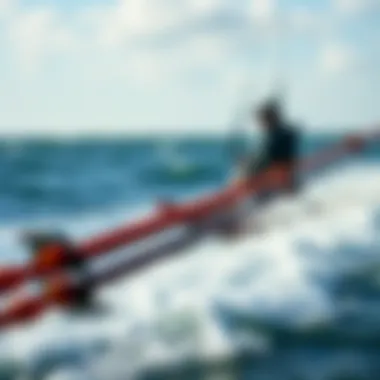

Effects on Maneuverability
Maneuverability is crucial in kiteboarding, especially for advanced riders looking to execute complex skills. The length of your lines can make a significant difference here:
- Short Lines: With shorter lines, the kite tends to fly closer to the water and the rider, allowing for quick response and tight turns. This can be particularly beneficial when navigating through challenging conditions, such as crowded waters or during waves.
- Long Lines: They provide a different dynamic. Longer kite lines allow the kite to fly higher, which can create a greater area of power extraction. However, this might make the kite a little less responsive on immediate steering commands, especially in strong winds. Riders may find themselves needing to input more effort into the steering, losing some of the agility that shorter lines offer.
In summary, the length of your kite lines profoundly impacts how your kite moves and responds. It influences everything from control and precision in turns to overall safety. Riders should thoughtfully consider their needs and conditions when deciding on the best lengths for their kite lines.
Construction Techniques of Naish Kite Lines
Understanding the construction techniques of Naish kite lines is crucial for enhancing performance and ensuring safety while kiteboarding. The manner in which these lines are crafted affects their strength, flexibility, and overall functionality on the water. Well-constructed kite lines offer durability, which is essential given the often harsh and demanding conditions faced by kiteboarders. Knowing the specifics of these construction methods can guide users in making informed choices that align with their riding style and conditions.
Braiding and Weaving Methods
Naish employs advanced braiding and weaving techniques when producing their kite lines. The idea behind these methods is to increase the structural integrity of the lines while maintaining lightweight characteristics. Braiding involves intertwining strands of material in such a way that it distributes stress evenly across the entire line. This helps to prevent localized wear and tear, which can be a common failure point in kite lines.
The most notable method used in Naish's kite lines is the use of a unique braiding pattern that enhances both strength and agility. Riders often notice that lines constructed this way maintain their shape better during intense sessions and do not stretch excessively over time. This aspect is particularly important for those who value precision and responsiveness in their maneuvers on the water.
Another significant feature is the use of double or sometimes triple braiding, which not only increases strength but also helps in providing better control. Riders may find that lines made from such braiding techniques offer smoother handling and improved performance when jumping and turning. This is a noteworthy consideration for anyone serious about optimizing their kiteboarding experience.
Reinforcement and Protection Features
In addition to the braiding methods, Naish incorporates various reinforcement and protection features that enhance the longevity of their kite lines. For example, specific areas that encounter the most friction—such as the points where the lines connect to the kite and the harness—often receive additional protective layers. These reinforcements are typically made from tougher materials that resist abrasion and wear.
Moreover, Naish kite lines often include low-stretch materials, which help maintain tension and reliability during rides. Riders frequently mention that lines with these features do not suffer significant elongation, allowing for consistent performance. The combination of these protective measures creates lines that withstand frequent use while minimizing the chances of breakage or failure.
Understanding the nuances of these construction techniques allows kiteboarders, instructors, and water sports enthusiasts to appreciate the engineering behind Naish’s gear. Knowing what goes into the making of quality kite lines enables users to choose wisely based on their individual needs and the rigors of the kiteboarding environment.
"The right kite line’s construction can make the difference between a thrilling ride and an unexpected fall. Choose wisely."
For further exploration of kite line technology and construction methods, you may consult relevant resources at Kiteboarding Wiki or Surf Industry Association for in-depth knowledge.
Maintenance of Naish Kite Lines
Maintaining your Naish kite lines is more than just a good practice; it's essential for ensuring safety, performance, and longevity in your kiteboarding experience. Just like a car needs regular servicing to keep performing at its best, your kite lines require attention too. Proper maintenance can help avoid wear and tear, which is crucial when you're out there flying across the water.
Cleaning and Storage Tips
Cleaning your kite lines after a session should be a non-negotiable part of your routine. Saltwater, sand, and dirt can build up over time, leading to potential damage and reduced performance. The process is straightforward:
- Rinse with Fresh Water: After a session, give your kite lines a thorough rinse with fresh water. This simple act removes salt and grit, preventing corrosion.
- Gentle Scrubbing: If you notice stubborn dirt, use a soft brush to gently scrub the lines without causing damage.
- Air Drying: Once cleaned, let your lines air dry completely before storing them. Avoid direct sunlight, as prolonged exposure can degrade the materials.
- Storage Considerations: When it comes to storage, keeping your kite lines coiled neatly prevents tangling and kinks. A dedicated bag or a simple storage container keeps everything organized and ready for your next adventure.
In addition to cleaning, consider the environment where you store your gear. A cool, dry place is ideal. Avoid damp basements or hot attics, as humidity and extreme temperatures can impact the integrity of the lines.
The Importance of Regular Inspections
Regular inspections of your kite lines can be the difference between a smooth ride and a potential accident. Over time, even the highest quality materials can wear, fray, or degrade under stress. Here are key reasons why inspections are critical:
- Identifying Damage Early: Frequent checks can reveal signs of wear before they become serious. Look for fraying, discoloration, or any irregularities.
- Maintaining Performance: Damaged lines can affect how your kite handles. Addressing issues promptly ensures optimal performance and responsiveness while riding.
- Enhancing Safety: Safety should always be the top priority. A line failure while you're airborne can lead to accidents. Regular inspections help prevent such scenarios by ensuring everything is in proper working order.
To facilitate inspections, consider setting a schedule—perhaps at the start of each season or after a set number of uses. During your check, pay close attention to the connection points, as these areas typically experience more stress.
Regular maintenance is a kiteboarder's best insurance against mishaps on the water. Basic care goes a long way in preserving your equipment and ensuring a safe ride.
By prioritizing both cleaning and inspections, you ensure that your Naish kite lines remain in top shape, ready for whatever the winds may throw your way. Embracing these practices not only preserves the life of your gear but also enhances your overall kiting experience.
For further guidance and tips, consider visiting resources like Wikipedia on Kitesurfing or engaging with the community on Reddit Kiteboarding.
Safety Considerations
Safety is at the forefront of any adventure sport, and kiteboarding is no exception. Having sturdy kite lines is crucial not only for performance but, above all, for rider safety. A simple oversight in maintenance or usage can significantly impact a kiteboarder's experience on the water. This section will explore key elements associated with the safety considerations of Naish kite lines, including recognizing wear and tear and adhering to proper usage guidelines.
Recognizing Wear and Tear
An often-overlooked aspect of kiteboarding is the condition of the kite lines. Daily use, exposure to saltwater, and direct sunlight can take a toll on these essential components. Here are some telling signs that it's time to reassess your lines:
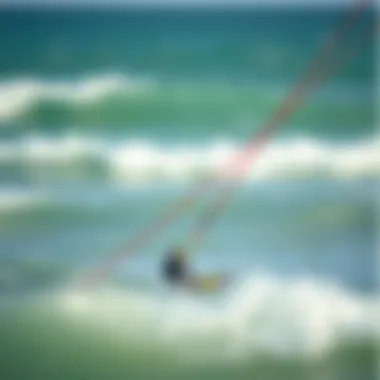
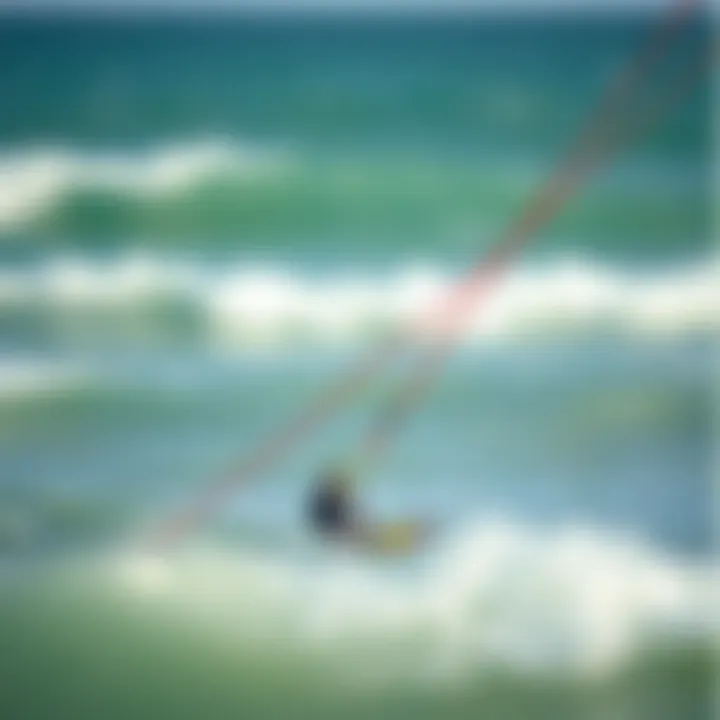
- Fraying: Look for any broken strands or fuzziness. Frayed lines can compromise strength.
- Discoloration: A change in color might indicate UV damage. If you notice a shift from vibrant to dull, your lines may be susceptible to failure.
- Stretching: Lines will naturally stretch over time, which can affect control. If you feel you’re not getting the same response from your kite, that could be a sign.
- Kinks or Bends: Inspect the lines for any knots or bends. These unusual shapes can impact how your kite flies.
Regular inspections should be part of your gear maintenance routine. It doesn't hurt to be a bit obsessive about this; after all, you're trusting your lines to keep you safely airborne!
Proper Usage Guidelines
Understanding how to properly use Naish kite lines is just as important as knowing when to replace them. Here are a few essential tips:
- Pre-Flight Checks: Always thoroughly inspect your lines before each session. Check for signs of damage, and ensure they are untangled and in good shape.
- Launch and Land Carefully: A careless launch or landing can lead to excessive stress on the lines. Make sure the area is clear, and take your time.
- Avoid Abrasion: Try not to let your lines rub against hard surfaces, sand, or any jagged objects. Wear and tear from abrasion can be insidious.
- Limit Exposure to Extreme Conditions: Prolonged exposure to harsh weather conditions can weaken your lines. Store your gear in a cool, dry place when not in use.
- Follow Manufacturer Guidelines: Each kite line will have specific recommendations for usage. Always refer to the care instructions provided by Naish to ensure you’re using your lines optimally.
"Taking the time to mind the details is what sets consistent kiteboarders apart from those who just dabble. Keep your lines in tip-top shape to not just fly but soar with confidence."
To sum up, safety considerations around Naish kite lines are non-negotiable. By recognizing wear and tear and adhering to proper usage guidelines, kiteboarding enthusiasts can enjoy their sport with much greater peace of mind. Remember, being proactive about the condition of your lines not only enhances your performance but also significantly boosts your safety out on the water.
Upgrading Your Kite Lines
Upgrading your kite lines can significantly enhance your kiteboarding experience. Whether you are a novice just catching the wind or a seasoned pro tearing it up on the waves, understanding when and how to upgrade your kite lines is crucial. Over time, wear and tear, advances in technology, and changes in your personal riding style will impact your equipment, and recognizing these elements can lead to better performance and safety.
This section will guide you through the signs indicating that it's time for an upgrade, and it will delve into how to select the best upgrades from Naish.
Signs It’s Time for an Upgrade
Knowing when to upgrade your kite lines is as important as understanding the lines themselves. Here are some key signals to watch out for:
- Visible Wear and Tear: Regularly check your lines for frayed sections or discoloration. If you notice significant damage, it’s time to consider new lines. A line that looks good may be masking internal weakness, so don’t take it lightly.
- Loss of Performance: If you feel less responsiveness during your rides—or if your kite has trouble staying in the air—it could be the lines. Older lines may not maintain their tension effectively, which can impact control and stability.
- Frequent Snapping: If you've noticed more frequent line breaks than before, that’s a sure sign they’ve reached the end of their lifespan. Replacing them sooner rather than later could prevent accidents on the water.
- Upgrades in Technology: Just like any other gear, kite lines undergo improvements. If new materials or designs are available that offer better performance or safety features, consider making a switch.
- Change in Riding Style: If your skills have progressed, you might want lines that suit your current technique better. Lines that worked when you were learning may not support the aggressive style of moves you’re now able to perform.
“A stitch in time saves nine.” Taking action early on ensures a smoother experience down the line.
Selecting the Best Upgrades from Naish
Upgrading your kite lines can seem like a daunting task, but Naish offers an array of products designed to cater to diverse preferences and needs. Here’s what to consider when selecting your next set:
- Compatibility: Make sure that the lines you choose are compatible with your existing kite gear. Naish lines are specifically designed to work harmoniously with their kites, ensuring that you don’t encounter any issues during use.
- Material Preference: Naish offers various line materials, from durable polyester to high-performance Spectra. Think about the conditions you most often ride in, and choose a material that will best suit those environments.
- Length Choices: Depending on your personal style and the specific kite’s requirements, selecting the right length can greatly affect your performance, so make sure to choose wisely. Shorter lines offer more direct control, while longer lines might provide improved lift in lighter winds.
- User Testimonials: Don't forget to tap into the community for insights. Reading what other riders have experienced can help steer you in the right direction. Forums like Reddit or brand-specific Facebook groups can provide valuable feedback on which lines others have had success with.
User Experiences and Testimonials
User experiences and testimonials hold significant value in the kiteboarding community, particularly when it comes to understanding gear effectiveness and performance. They provide insights that go beyond technical specifications and manufacturing details. These first-hand accounts reflect real-world conditions, helping shoppers make informed decisions. For Naish kite lines, feedback can cover aspects such as durability, maintenance ease, and overall kiteboarding experience.
Community Feedback on Naish Lines
Feedback from fellow kiteboarders about Naish lines often highlights the high-performance aspects of the gear. Riders frequently mention how these lines perform under various conditions—be it fierce winds or calm seas. For example, a seasoned rider might share that during a recent trip to Hood River, the Naish lines outperformed several competitors in terms of responsiveness and control during jumps.
This community chatter often takes place on platforms like Reddit.com and Facebook groups dedicated to kiteboarding. Here, users exchange tips and experiences that can be beneficial for newcomers and veterans alike. Key points reported by users include:
- Durability: Many have noted lower wear rates compared to other brands, which suggests improved longevity.
- Performance Consistency: Riders mention that Naish lines remain reliable, delivering consistent performance over long periods.
- User Support: The community often praises Naish’s customer service, making it easier to resolve any issues.
Overall, testimonials provide a straightforward view of how Naish kite lines may elevate or hinder one's kiteboarding adventure.
Comparisons with Other Brands
When it comes to evaluating Naish kite lines, context is paramount, especially comparisons with other brands. Some riders engage in discussions comparing Naish with brands like Cabrinha, Duotone, and Flexifoil. Comparisons often highlight the unique benefits that Naish products offer.
From that perspective, considerations include:
- Material Quality: Naish’s use of advanced materials often sets it apart, creating a feeling of reliability that some competitors may lack. Riders frequently share experiences that indicate Spectra constructions from Naish provide a better balance of flexibility and strength.
- Line Length and Adjustability: While many brands offer fixed sizes, Naish tends to deliver variability in their line lengths, which can enhance performance during tricks and turns. Users have shared how changing line lengths impacted their control, leading to a discussion on personal preferences.
- Price Point: While some riders deem Naish lines to be on the pricier side, others argue that the investment is justified due to the performance and safety they provide. Therefore, pricing conversations often lead to discussions about the value proposition.
Epilogue
Bringing everything together in this guide, it’s clear that Naish kite lines are more than just a simple accessory in the kiteboarding realm; they play a fundamental role in improving both the performance and safety of the rider. Choosing the right kite lines has the potential to enhance every aspect of the ride—whether it’s for leisure, competition, or specific maneuvers. Kite lines from Naish, known for their quality and innovation, ensure that you’re not leaving any potential on the table.
Recap of Key Points
- Types of Lines: We explored the variety of lines, from standard to performance and specialty, that Naish offers, each designed for specific conditions and rider needs.
- Materials Matter: The choice between polyester and Spectra significantly impacts durability and responsiveness, which are crucial for any kiteboarding session.
- Length and Maneuverability: Correct line length can make or break your control during tricks, affecting your overall riding experience.
- Construction Techniques: Understanding how lines are made helps in recognizing what features to look for, such as reinforcement and protection against wear.
- Maintenance: Regular inspections and proper care can extend the life of your kite lines, ensuring a consistent experience on the water.
Proper kite line maintenance is not just about prolonging the life of your gear; it’s about ensuring your every ride is as safe and enjoyable as it can be.
Future Trends in Kite Lines
Looking forward, the kiteboarding industry is not static. Continuous advancements in materials and technology influence the design of kite lines. Innovations may include:
- Smart Materials: Anticipate research into lines that adapt to changing environmental conditions, adjusting their flexibility for performance.
- Eco-Friendly Options: As sustainability becomes a priority in many industries, the shift towards environmentally responsible materials will likely affect kite line production.
- Enhanced Durability: With technological developments, new methods may emerge to enhance the resilience of lines against the rigors of the sport.
Staying abreast of these trends is essential for riders looking to optimize their gear and experience. The future of kite lines looks promising, and Naish is likely to remain at the forefront of it all.



